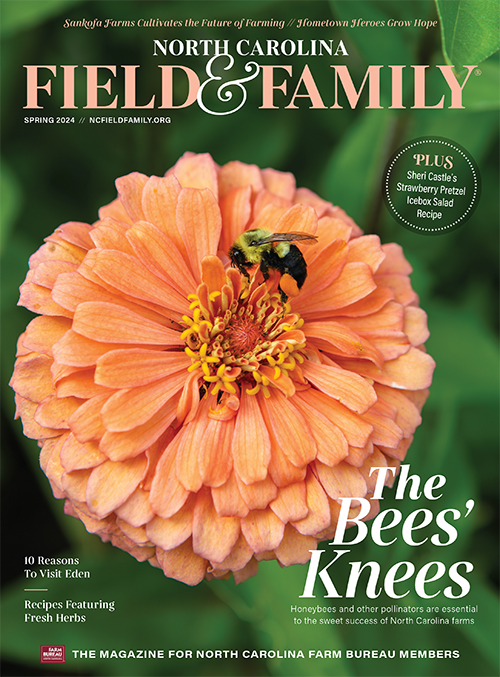North Carolina’s Fishing Industry Catches Up to a Changing World
North Carolina's fishing industry adjusts to economic and environmental challenges.
Farm Bureau |
Fishing for a living is not for the faint of heart. Commercial fishing was the second deadliest job in America in 2012, ranked just behind logging, according to the U.S. Bureau of Labor Statistics.
Rough seas and long hours aren’t the only challenges fishermen face. A volatile global seafood market and a complex web of state and federal fishing regulations can catch fishermen in economic gales and regulatory storms.
The workers of North Carolina’s fishing industry, however, are adopting innovative ways to run businesses that provide fresh, wild-caught seafood, scaling their operations to meet economic, regulatory and environmental challenges.
One of those commercial fishermen is 27-year-old Nathan Everett, a Pinetown native.
“If I listened to every old-timer who tells me how good it was in his day and that it’s a dying industry, I would quit,” Everett says.
Everett is the first commercial fisherman in his family.
“I was 12 years old, and I ate lunch in the summer at my grandmama’s,” he says. “My cousins who were a little older than me would join us after they’d finish priming tobacco. That didn’t look like a good job for me, so I decided I better find something else.”
The young boy landed a job on a crabbing boat on the Pamlico River. His parents, Beaufort County Farm Bureau members, supported his interest in working on the water and drove him to the dock in the early morning hours.
By the time he was 15, Everett had his own boat, which he and his father refurbished, and enough money to start his own crabbing operation with 150 pots. After high school graduation, he captained an Albemarle Sound crab boat and crewed on boats fishing the ocean in the winter before stepping up his investment in the industry.

Like many other North Carolina captains, Everett fishes with gill net and typically hires one crewman to help bring in Spanish mackerel, bluefish, croaker, spiny dogfish, and other fish.
He fishes out of Hatteras village in Dare County, the top seafood producing county in North Carolina. Dare County fishermen landed 24.6 million pounds of seafood valued at $22.5 million in 2011, according to the state Division of Marine Fisheries.
Everett says Hatteras, wedged between the ocean and Pamlico Sound, offers a fishing diversity not found in many other locations.

“But options also can starve a man to death in this business sometimes,” he cautions. “You have to stay focused.”
Everett sees opportunities on the horizon as more fish stocks bounce back from unsustainable population levels and managers adjust fishing regulations.
“We have fish like dogfish that are healthy, where regulators are increasing harvest limits, and we could better capitalize on those if we find ways to develop new markets and the infrastructure to get those fish to consumers,” he says.

Louis Daniel, director of the North Carolina Division of Marine Fisheries, agrees.
“In the future, fishermen should see more opportunities as more stocks recover, opportunities that could provide a stronger economic return with development of more in-state, added-value processing and product development,” Daniel says.
Still, challenges to the long-term viability of the industry remain.
About 91 percent of seafood consumed in the United States is imported, according to the National Marine Fisheries Service, and imports undercut domestic prices.
SEE ALSO: Fresh Fish and Seafood Recipes
A North Carolina Sea Grant study found that the state lost more than one-third of its fish houses, where fishermen unload their catch for packing and shipping to wholesale markets, in the last decade.
The North Carolina Division of Marine Fisheries reports that the number of active fishermen in the state has declined 43 percent since 1994, dropping to 2,951 participants this year.
In 2012, commercial fishermen harvested 56.7 million pounds of fish and shellfish from North Carolina coastal waters, a 16 percent drop from 2011, according to the Division of Marine Fisheries. Severe shoaling of Oregon Inlet has resulted in many large vessels steaming to Hampton, Va., to unload rather than risk passage though the treacherous inlet to Wanchese.
Dare County Farm Bureau member Dewey Hemilright says hurricanes in 2011 and 2012 intensified shoaling, reducing the channel’s depth to as little as 2 feet at times. Hemilright runs his 42-foot boat from Wanchese through the inlet to reach fishing grounds.

His annual round of fishing includes longlining for tuna and swordfish in the fall, gillnetting spiny dogfish, gillnetting croaker and bluefish until April, and longlining for dolphin and tilefish in the summer.
“It’s kind of like the lugnuts on a tire. You have to have each of them to make it work,” he says.
The Kitty Hawk native also devotes many hours to advocacy work on behalf of the fishing industry, work that landed him a National Fisherman magazine Highliner award in 2012.
One project close to Hemilright’s heart is Provider Pals, a program that partners schools with professionals working with natural resources. In the eight years he has been with the program, he has visited classrooms in places from Montana to New York City to tell students about his job. This year he teamed up with the North Carolina Coastal Federation to visit classrooms in coastal North Carolina.
Hemilright also volunteers with Outer Banks Catch, a local seafood branding initiative focused on consumer education. Outer Banks Catch works with Brunswick Catch, Carteret Catch, and Ocracoke Fresh to educate consumers about the availability and seasonality of North Carolina seafood. Last year, the groups formalized their association and organized NC Catch, an umbrella nonprofit that facilitates local and statewide efforts.
Most seafood landed in North Carolina is trucked north to major markets in metropolitan areas, but more in-state markets are developing. Entrepreneurs have found new opportunities moving seafood from the coast to inland restaurants, retailers, and farmers’ markets. Community supported fisheries programs are connecting fishermen and consumers as fishermen begin to borrow market diversification strategies used by farmers.
Susan West, a correspondent and journalist, lives on Hatteras Island. She served on the North Carolina Joint Legislative Commission on Seafood and Aquaculture from 2003 to 2011.



I have been trying to find information about crab fishing. I am trying to find out what I need to get started. Is there anyone wanting to sell their crabbing business, such as their boat and crabbing license? I have been talking with a person in Maryland where they have several boats and license they wish to sell. I live in Norht Carolina and would like to crab here if possible. Also if there are any classifieds in newspapers or a Watermans Associations please e-mail their addresses.
Thanks very much,
My e-mail address again is: re6961@aol.com
Currie Edwards
Hi Currie,
Thanks for your comment. We are a publication that did a story about North Carolina’s fishing industry, and are not directly involved with starting a business in the field. We suggest you contact the North Carolina Department of Agriculture Aquaculture Division at (828) 524-1264. The North Carolina Division of Marine Fisheries might also be able to help. They can be reached at (252) 808-8013. Hope this helps!
Rachel
editor
North Carolina Field and Family